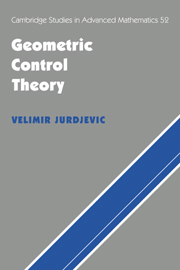Book contents
- Frontmatter
- Contents
- Introduction
- Acknowledgments
- Part one Reachable sets and controllability
- 1 Basic formalism and typical problems
- 2 Orbits of families of vector fields
- 3 Reachable sets of Lie-determined systems
- 4 Control affine systems
- 5 Linear and polynomial control systems
- 6 Systems on Lie groups and homogeneous spaces
- Part two Optimal control theory
- References
- Index
2 - Orbits of families of vector fields
Published online by Cambridge University Press: 07 October 2009
- Frontmatter
- Contents
- Introduction
- Acknowledgments
- Part one Reachable sets and controllability
- 1 Basic formalism and typical problems
- 2 Orbits of families of vector fields
- 3 Reachable sets of Lie-determined systems
- 4 Control affine systems
- 5 Linear and polynomial control systems
- 6 Systems on Lie groups and homogeneous spaces
- Part two Optimal control theory
- References
- Index
Summary
A basic property of families of vector fields is that their orbits are manifolds. This fact, known as the “orbit theorem,” marks a point of departure for geometric control theory, although from a more general mathematical perspective the theorem can also be seen as a fundamental result serving the needs of geometry, dynamical systems, mechanics, and control theory.
This chapter contains a proof of the orbit theorem, along with a self-contained treatment of the closely related integrability results, including the Frobenius integrability theorem and the Hermann-Nagano theorem concerning the orbits of families of real analytic fields. The latter theorem shows that the local structure of each orbit defined by a family of analytic vector fields is determined by the local properties of the vector fields in the family. This property of orbits, essential for geometric control theory, defines a distinguished class of families of vector fields, called “Lie-determined,” large enough to include families of real analytic vector fields, whose orbits admit easy descriptions in terms of Lie theoretical and algebraic criteria.
The basic theory developed in the first part of this chapter is directed to Lie groups, homogeneous spaces, and families of vector fields subordinated to a group action, partly to illustrate its use in the classic theory of Lie groups, but more importantly to establish the conceptual framework required for subsequent analysis of differential systems on Lie groups. The chapter ends with the fundamental properties of zero-time orbits required for the study of reachable sets in the next chapter.
- Type
- Chapter
- Information
- Geometric Control Theory , pp. 32 - 63Publisher: Cambridge University PressPrint publication year: 1996

